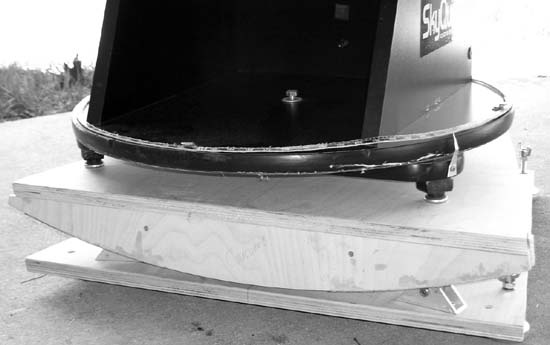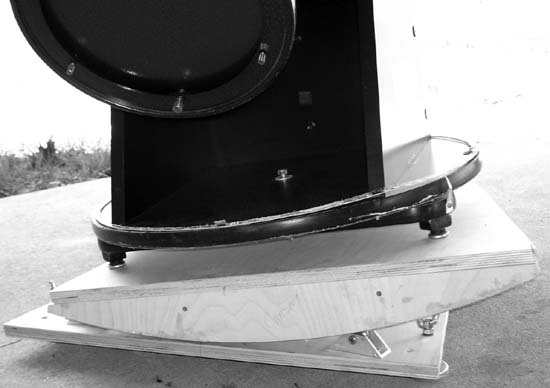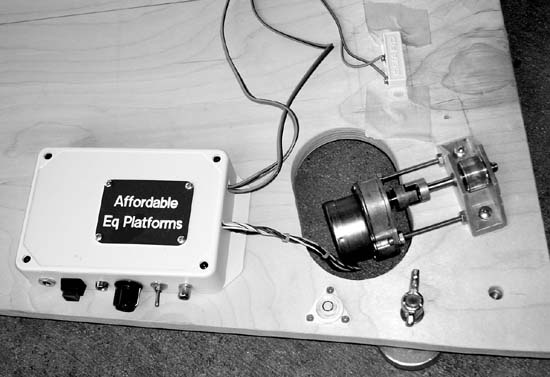The Dobsonian mount was a wonderful innovation.It’s simple, inexpensive, smooth, extremely stable, and intuitive to use. The only downside is that a Dob doesn’t track the motion of the stars. Or at least it doesn’t unless you put it on an equatorial platform.
An equatorial platform,or EQ platform for short, is a squat, flat, motor-driven table that sits underneath the Dob base and gradually pivots the scope at the exact rate needed to counteract the apparent motion of the stars. When you use an EQ platform, you continue to point the Dob normally, moving it in altitude and azimuth to locate objects. The difference is, when you stop moving the Dob, it begins tracking and the object in the eyepiece remains centered rather than drifting out of view as Earth rotates. Figure4-37 shows an EQ platform built by Steve Childers, underneath the rocker box of his 10” Orion XT10 Dob.
The equatorial platform pivots on the curved bearing shown in Figure 4-37, as well as a similar bearing at the far end of the platform, not visible in the figure. The bearing dimensions are calculated for the specific latitude at which the platform is to be used.
Using an EQ platform preserves all of the advantages of a Dob—large aperture; easy, intuitive motions, and so on—while adding all of the benefits of a driven equatorial mount. (Well, all but one; the Dob is still an altazimuth scope in terms of motions, which means you can’t use the old EQ guys’ trick of locating a bright object and then using the RA or declination slow motion controls to repoint the scope to a dim object on the same RA or declination line.) But the EQ platform is a real equatorial mount in every sense of the word. It just doesn’t look like a standard GEM or fork equatorial mount.
Tip
Because an EQ platform tracks equatorially rather than alt-azimuthly (as, for example, a standard fork mount without an EQ wedge or a Dob Driver does), there is no field rotation during tracking. That means an EQ platform, if it is built precisely and polar aligned accurately, can be used for long-exposure astrophotography without requiring hardware or software field derotators.
Because the scope simply sits on top of the EQ platform rather than being attached to it, the range of motion is necessarily limited to prevent tipping. Most EQ platforms tilt from about -7.5° through vertical to +7.5°. This 15° range provides about one hour of tracking time. When the EQ platform reaches the end of its travel, you simply reset it for another hour’s worth of tracking. Some EQ platform designs provide motorized rewinding, which takes a couple of minutes. Others allow you to reset the platform manually, simply by pivoting it back to the starting position, which takes only seconds. Figure 4-38 shows an EQ platform at one extreme of its motion, with the scope about 7.5° off vertical.
Like any equatorial mount, an EQ platform must be polar aligned if it is to track stellar motion properly. For visual use, a rough polar alignment works fine. You simply place the EQ platform with the north-south central axis pointing more or less north. Polar alignment within a couple degrees is sufficient for visual use. You can do an eyeball alignment on Polaris, or use a compass (adjusting for magnetic declination, of course) to align the platform accurately enough for visual use up to 300X or more.
Tip
For astrophotography, the polar alignment needs to be much more precise. You can use any of the standard methods that astrophotographers use for critical polar alignment, including drift alignment or a polar-alignment scope. Commercial platforms that are sufficiently precise for long-exposure astrophotography (which is to say platforms built by Tom Osypowski) offer optional polar-alignment tools.
An EQ platform is simple in concept. The ground board, typically a sheet of stiff plywood, has adjustable feet that allow the platform to be leveled (an adjustable foot is visible at the lower right of Figure 4-39). The scope sits on top of the top board, which is usually another sheet of stiff plywood. Between the two boards sit the north and south bearings, a small motor, and some sort of drive mechanism that tilts the top board (and scope)to track the stars. The controller needed to adjust tracking speed may be a separate box that is cabled to the platform, or it may be built into the platform base. Figure 4-39 shows the ground board of Steve Childers’ EQ platform.
The white box on the left contains the electronics that control the speed of the platform’s motion. The stepper motor, which actually moves the platform, is visible in the oval cutout. It connects via a drive shaft to the drive wheel visible at right in the aluminum bracket assembly. That drive wheel bears against and drives the curved bearing surface connected to the top board, upon which the scope rests.
You can buy a commercial EQ platform or build your own EQ platform from scratch. Even commercial platforms are not off-the-shelf items, though, because a platform must be adjusted specifically to the latitude where you use it and the center of gravity of the scope you plan to mount on the platform.
Tip
At least one commercial platform, the Johnsonian Type V, is adjustable for latitude within a wide range. Most platforms, commercial or home-built, are set for one specific latitude, although you can adjust them to ±5° or so by shimming up the north or south end. In practice, that means that most platforms are made for the owner’s specific latitude, but are usable anywhere within 350 miles north or south of that location.
The most popular commercial platforms are made by Sam Johnson ( http://www.johnsonian.com) and Tom Osypowski(http://astronomy-mall.com/regular/products/eq_platforms/). Both of these come highly recommended by their owners, but neither is inexpensive. The dual-axis, aluminum Johnsonian Type V platform sells for $900 and supports Dobs up to 16” or 140 pounds. The Johnsonian Type VI platform is an entry-level model that sup-ports Dobs up to 10” or 60 pounds. The Type VI was announced in spring 2005 at an introductory price of only $399. Osypowski platforms range in price from $925 for a basic single-axis wooden model suitable for 6” to 11” Dobs to $4,250 for a dual-axis aluminum model suitable for 28” to 32” Dobs. Although these prices sound high, compared to the price of a traditional equatorial mount large enough to support scopes that size, a platform starts to sound like a bargain.
Many amateurs choose to build their own EQ platforms to save money, as well as to customize the platform to their own preferences. If you’re comfortable with the idea of building a platform from scratch, you can probably do so for $150 to $200 in materials and two or three weekends’ work. You’ll need to calculate dimensions, center of gravity, bearing curves, and so on for yourself, but there are spreadsheets and other tools available to help with all that. Here are several online resources to help you get started:
eqplatforms group (http://groups.yahoo.com/group/eqplatforms)
Chuck Shaw’s EQ platform page (http://www.atmsite.org/contrib/Shaw/platform/)
Jan van Gastel’s EQ platform page (http://home.wanadoo.nl/jhm.vangastel/Astronomy/Poncet/e_index.htm)
Don Odegard’s EQ platform page (http://home.att.net/~segelstein/don/platform-1.html)
David Shouldice’s EQ platform page (http://members.tripod.com/denverastro/dsdfile/dspfile.htm)
Tom Hole’s EQ platform page (http://www.tomhole.com/EQ%20Platform.htm)
An EQ platform may not be the best choice for large Dobs because it raises the Dob (and the eyepiece height) by 6” or so. For small Dobs, this may actually be welcome. Large Dobs already require a stepladder to reach the eyepiece when the scope is pointed near zenith, so another 6” of height might be the last thing you want. But for small and mid-size Dobs, those 12"or less, many astronomers think an EQ platform is the best single upgrade you can make.
Get Astronomy Hacks now with the O’Reilly learning platform.
O’Reilly members experience books, live events, courses curated by job role, and more from O’Reilly and nearly 200 top publishers.




